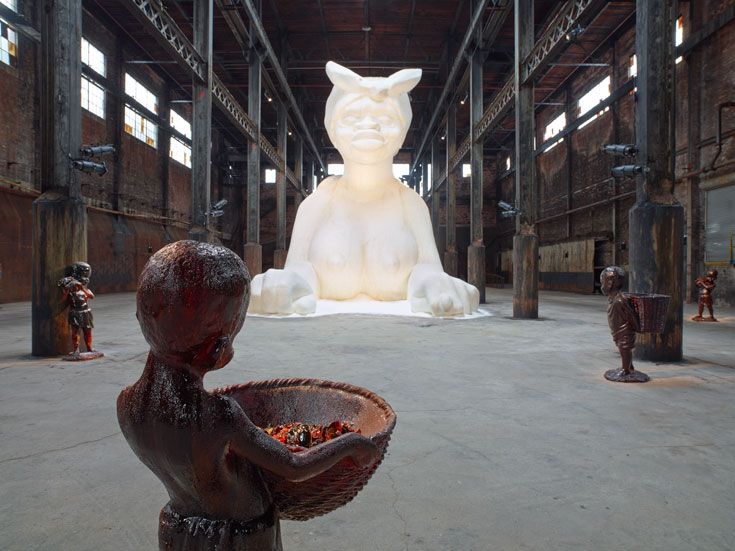Artist Kara Walker incorporates
space in her explorations of identity, race, gender, and violence. Gone: An
Historical Romance of a Civil War as It Occurred b’tween the Dusky Thighs of
One Young Negress and Her Heart (1994) and A Subtlety, or the Marvelous
Sugar Baby (2014) both impact and are impacted by historical narratives, inviting
spectators to be audience members. The first piece is a wall art installation
of silhouettes cut from black paper. In addition to the title, these eighteenth-century
caricatures allude to Mitchell’s (1936) Gone with the Wind, a literary
work that impacted Walker. She was captivated by the novel but frustrated by the
heroine’s limited perspective; Scarlett O’Hara’s lens illuminates nuances that
have resounding implications for positionality Walker later suggests ("A Subtlety, or the Marvelous Sugar Baby",
2014) .
Thus, her installation is her subsequent personal tension as an African
American reader, “wanting to be the heroine and wanting kill the heroine at the
same time” ("A Subtlety, or the
Marvelous Sugar Baby", 2014) . This visual
storytelling utilizes projectors to augment the white walls and black figures
into a cyclorama, which is a panoramic image often associated with depictions
of Civil War battles. Walker’s (1994) piece plays with depth and perception, while
also acting as an illusion. The silhouettes themselves could simply suggest the
past, yet also embody avoidance; one doesn’t look directly at the subject—being
the figure—which notates a narrative that is often silenced.
Ten years later, the sphinx and Mammy
archetype transform into a gigantic sugar sculpture. A Subtlety, or theMarvelous Sugar Baby (2014) notates power dynamics itself, let alone being
within a former Domino Sugar Factory. A “subtlety” was a miniature sugar sculpture
depicting royalty and for royal consumption. Incorporating Mammy within a
different context challenges its associated connotations of servitude; her position
isn’t one of subjection or abuse, but rather withholding. Additionally, she’s surrounded
by thirteen children formed from molasses. This juxtaposition of a desired commodity—sugar—and
its unwanted, lingering bi-product—molasses—shows exploitation and marginalization;
slaves often harvested sugar for the white and wealthy. However, shaping bodies
from both sugar and molasses highlights slaves as individuals, materializing
their experience.
Thus, while they explore power
dynamics, Walker’s artworks resonate with Mitchell’s “representations of space”
and “representational space” (1995). The Domino Sugar Factory—once a place of
industry, capital, and order—became disordered by molasses sticking to its
walls but then reclaimed by Walker, who sought visibility for a population.
While I’m sure she’d like individuals to view her work, A Subtlety, or the
Marvelous Sugar Baby (2014) sought to legitimize a narrative that often is
overshadowed by Protestant colonists. In her interview with Art 21, Walker
states, “What ‘black’ stands for in White America, what ‘white’ stands for in
Black America are all loaded with our deepest psychological perversions, and fears,
and longings” (2014). Ultimately, Walker’s pieces notate space’s tendency to be palpable
yet abstract, manipulating social and cultural codes to offer different meanings
(Hamdan-Saliba & Fenster, 2012)
References
"A Subtlety, or the Marvelous Sugar Baby". (2014, May 23). Retrieved from Art 21:
https://art21.org/watch/extended-play/kara-walker-a-subtlety-or-the-marvelous-sugar-baby-short/
Contemporary Art from the Collection- Kara Walker. (2010-2011). Retrieved from The Museum of Modern
Art: https://www.moma.org/collection/works/110565?
Kara Walker.
(2019). Retrieved from Walker Art Center: https://walkerart.org/collections/artists/kara-walker
Hamdan-Saliba, H. and Fenster, T. (2012). "Tactics and
Strategies of Power: the Construction of Spaces of Belonging for Palestinian
Women in Jaffa-Tel Aviv." Women's Studies International Forum 35:
203-213.
Mitchell, D. (1995). "The End of Public Space?: People's
Park, Definition of the Public, and Democracy. Annuals of the Association
of American Geographers 85:108-133.




Comments
Post a Comment